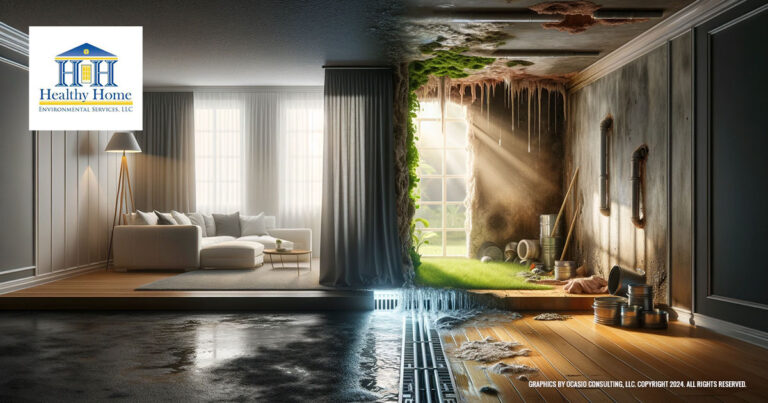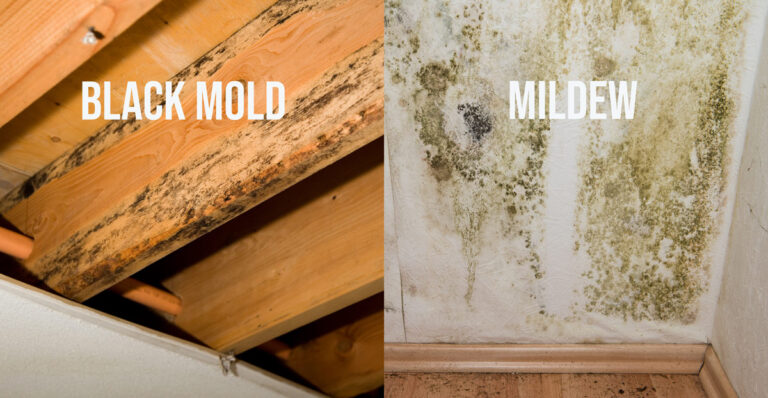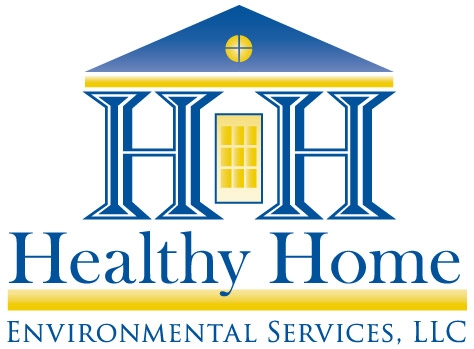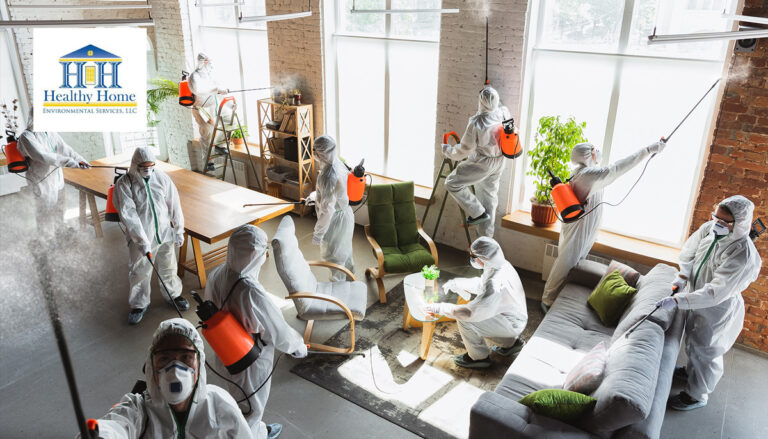Recognizing Mold Symptoms in Your Home – Our Guide

Introduction to Mold Symptoms in Your Home
Mold is a common problem in households across the United States, and it can cause serious health issues if not identified and treated promptly. Mold grows in damp and humid areas of your home and is often invisible, making it challenging to recognize and detect.
In this guide, we will help you identify the signs of mold growth in your home and provide insights into how to address potential health effects associated with mold exposure.
If you suspect you have a mold problem in your home, it’s essential to act quickly to prevent the situation from worsening. In this section, we will discuss the following:
- The health effects of mold exposure
- Common signs of mold growth
- Allergy symptoms associated with mold exposure
- The potential health risks of mold in your home
- How to detect mold in your home
- Effective treatment and removal strategies for mold
- Preventive measures for inhibiting future mold growth
- The importance of professional mold inspection and testing
Key Takeaways:
- Mold symptoms in the home can cause serious health issues if not addressed promptly.
- Identifying the signs of mold growth and understanding the potential health effects of mold exposure is crucial.
- Acting quickly to address mold growth is key to preventing the situation from worsening.
- Effective treatment and removal strategies for mold, preventive measures, and professional inspections can help ensure the well-being of your household.
- If you suspect mold in your home, seeking professional assistance is recommended for thorough inspection and testing.
Common Signs of Mold in Your Home
If you suspect that you may have a mold problem in your home, it’s crucial to recognize the common signs of mold growth. Here are 11 signs that may indicate the presence of mold:
| Sign of Mold | Description |
|---|---|
| Musty Odor | A persistent, earthy smell that may indicate mold growth. |
| Visible Mold | Mold growth that is visible on surfaces such as walls, floors, and ceilings. |
| Water Leaks | Past or current water leaks can create a favorable environment for mold growth. |
| Condensation | Water droplets on windows and other surfaces can indicate excess moisture in your home. |
| Water Stains | Discoloration or staining on walls, ceilings, or floors caused by water intrusion. |
| Bubbling or Peeling Paint | Mold growth behind walls or ceilings can cause paint to bubble or peel. |
| Warped or Buckled Flooring | Excessive moisture can cause wood and laminate flooring to warp or buckle. |
| Health Symptoms | Symptoms such as allergies, respiratory issues, and headaches may be an indication of mold growth. |
| Insect Infestation | Insects such as ants and cockroaches are attracted to mold growth and may be an indication of its presence. |
| Humidity | High levels of humidity in your home can create conditions conducive to mold growth. |
| No Visible Signs | In some cases, there may be no visible signs of mold growth, but you may still experience symptoms or suspect its presence. |
If you notice any of these signs, it’s important to test for mold to confirm its presence, identify the type of mold, and address any potential health or property risks. You can test for mold in different areas of your home, including air samples, surface samples, and bulk samples. However, it’s recommended to seek professional assistance for thorough testing and removal to ensure the proper handling of mold in your home.
Allergy Symptoms Associated with Mold Exposure
When it comes to mold exposure, the health effects can be severe. One common problem that many people encounter is the development of allergies due to prolonged exposure to mold spores. Even if you are not allergic to mold, extended exposure can trigger an allergic reaction that can lead to numerous health issues.
Some allergy symptoms associated with mold exposure include:
- Wheezing and difficulty breathing
- Coughing and sneezing
- Runny or stuffy nose
- Itchy and watery eyes
- Skin irritation or rash
It is important to note that mold spores are everywhere, but when they grow to high levels, they can cause health problems. If you already suffer from allergies, exposure to mold spores can worsen your condition. For those who are allergic to mold, the symptoms can be severe and may include shortness of breath, chest tightness, and even fever. Black mold, in particular, can cause a range of health issues, such as respiratory problems, memory loss, and other mold-related health issues.
To reduce the risk of developing mold allergies, it is essential to keep your home mold-free. Regular cleaning and maintenance can help prevent mold growth and reduce your exposure to mold spores. Additionally, if you suspect that mold is present in your home, it is recommended to seek professional assistance for proper inspection and testing to identify the type and extent of the mold growth.
Understanding the Health Risks of Mold
At first glance, mold may seem like a mere nuisance, but it can actually cause serious health problems. The Centers for Disease Control and Prevention (CDC) warns that exposure to mold can lead to numerous health issues, especially for people with respiratory problems or compromised immune systems. In this section, we will explore the health risks associated with mold in your home.
Health Problems Caused by Mold
Exposure to mold can cause serious health problems, including:
- Worsening of asthma symptoms
- Irritation of the eyes, nose, and throat
- Coughing and wheezing
- Skin irritation
- Headaches
- Chronic fatigue
- Mental confusion or difficulty concentrating
- Organ damage in extreme cases
Black mold, a particularly dangerous type of mold, can cause more severe health problems with long-term exposure. According to the CDC, black mold exposure can lead to:
- Respiratory problems, including difficulty breathing and chest pain
- Nosebleeds and other bleeding disorders
- Headaches and dizziness
- Memory loss and other cognitive issues
- Mood changes
Mold Growth in Your Home
Mold can grow anywhere in your home with the right conditions, including moisture, warmth, and organic matter. Common areas for mold growth include bathrooms, kitchens, and basements. You may not even realize that mold is growing in your home until you start experiencing symptoms.
Preventing Health Problems from Mold
To prevent health problems from mold exposure, it is important to address any mold problems in your home as soon as possible. Treatment may involve cleaning and removing the mold, fixing any moisture problems, and improving ventilation in your home. In some cases, professional mold remediation may be necessary.
Detecting Mold in Your Home
When it comes to detecting mold in your home, it’s essential to pay close attention to any indication of mold growth. Although there is always a chance that mold is present, some areas in your home are more susceptible to mold contamination than others. Being mindful of these areas and their potential for mold growth can help you detect and address the issue early on.
Some common areas for mold growth in your home include damp and humid areas like basements, bathrooms, and kitchens. However, mold can also grow in less obvious areas like behind walls and ceilings or under carpets and floorboards. So, it’s essential to inspect your home thoroughly for mold contamination regularly.
One of the easiest ways to detect mold in your home is by sight and smell. If you notice any visible mold growth, a musty smell, or water stains on walls or ceilings, there might be mold growing in your home. Additionally, if you or a family member experience symptoms like coughing, sneezing, or itchy eyes, mold contamination may be a factor.
To know precisely the type of mold present in your home, a mold test can be conducted. Mold testing can identify the type and extent of mold growth and, consequently, help determine the best course of action for removal and remediation. Professional inspectors can perform this type of testing and provide you with a comprehensive report on their findings.
Treating and Removing Mold
When it comes to treating and removing mold from your home, it’s essential to do it right to reduce the risk of recurring mold growth and prevent possible health hazards. Fortunately, there are various methods to remove or eliminate mold, depending on the severity and location of the mold problem.
Clean the Mold
If the mold growth is small and limited to a particular area, you may be able to clean it yourself. However, you should take precautions to avoid exposure to mold spores that can lead to serious health issues.
First, wear protective gear, such as gloves, eye goggles, and an N95 respirator mask, to protect yourself from inhaling mold spores. Then, prepare a cleaning solution by mixing equal parts of white vinegar and water or bleach and water. Use a soft-bristled brush or a sponge to scrub the mold gently. Make sure to dry the area thoroughly after cleaning to prevent mold from growing back.
Remove the Mold
If the mold growth is extensive or widespread, it’s best to leave the removal to the professionals. Licensed mold remediation specialists have the necessary equipment, expertise, and experience to remove mold safely and effectively. They can also address moisture issues that contribute to mold growth, preventing future infestation.
Reduce Your Exposure
During the mold removal process, mold releases spores into the air that can irritate your respiratory system and cause allergic reactions. To reduce your exposure to high levels of mold spores, you should isolate the affected area by sealing off doors and windows with plastic sheeting and duct tape. Additionally, you may want to consider temporarily relocating to a hotel or a friend or family’s home during the removal process.
Eliminate Mold
The best way to eliminate mold is to eliminate the source of moisture that feeds it. You should inspect your home for any water leaks, humidity issues, or condensation problems that contribute to mold growth. Fix any leaks promptly, keep indoor humidity levels below 60%, and ensure adequate ventilation in areas that tend to be damp, such as bathrooms, kitchens, and basements.
Preventing Future Mold Growth
It’s essential to take preventive measures to inhibit future mold growth in your home. Mold can cause serious health issues, so it’s crucial to identify and eliminate areas of your home that are susceptible to mold growth. Here are some ways to prevent mold growth:
- Control humidity in your home: Mold might be growing in your home due to excess moisture. Keep indoor humidity levels below 60%. You can use dehumidifiers in areas of your home that have high moisture levels like basements and bathrooms.
- Fix leaks: Leaks in your plumbing system or roof can encourage mold growth. Inspect and repair any leaks as soon as possible.
- Ensure proper ventilation: Proper ventilation can help to reduce the chances of mold growth. Open windows and use exhaust fans in areas of your home like the kitchen and bathroom to remove excess moisture.
- Clean and disinfect: Mold might be growing in areas that are not visible or hard to reach. Regularly clean and disinfect areas like your kitchen and bathroom sinks, floors, and countertops.
You should also be aware of areas of your home that might be causing mold growth. For example, if you have a damp basement or a leaky roof, it’s essential to address these issues as soon as possible. Mold can grow quickly, so it’s important to take action promptly.
If you are currently dealing with mold issues in your home or office, contact a local mold home inspector to assist you right away.
Professional Mold Inspection and Testing
When it comes to addressing mold growth in your home, seeking professional assistance is crucial. A licensed mold inspector can provide a thorough assessment of the extent of mold growth in your household and identify the type of mold that is present.
Mold testing is a critical part of the inspection process, as it determines the concentration of mold spores in the air and helps to evaluate the potential health risks. Testing can also pinpoint the areas of your home that are most affected by mold growth, allowing for targeted treatment and remediation.
Licensed Mold Inspection
A licensed mold inspector has the expertise to detect the presence of mold in areas that are often overlooked. They can examine hidden areas such as behind walls and under floorboards and can identify the source of moisture that is causing the mold growth.
The inspector can also evaluate the overall health of your indoor air quality and determine if there are other allergens present that could be contributing to poor air quality.
Mold Testing
Mold testing involves taking air samples from different areas of your home and testing them in a laboratory for the presence of mold spores. The results of the test allow the inspector to determine the type and concentration of mold spores in your home, as well as the potential health risks associated with exposure to the mold.
High levels of mold spores in the air can be a serious health risk, especially for individuals with allergies or respiratory issues. IAQ testing can provide valuable information on the steps you need to take to protect your health and prevent further mold growth in your home.
Ensuring Your Home
Regular mold inspection and testing can not only help protect your health but can also prevent damage to your home. Mold growth can cause significant structural issues and can lead to costly repairs if left untreated.
By ensuring that your home is free from mold, you can maintain the value of your property and avoid unnecessary expenses in the long term.
Conclusion
As we conclude this guide, we must emphasize the importance of recognizing and addressing mold symptoms in your home. It is crucial to protect your household from the serious health issues that can arise from exposure to mold.
Early Detection and Action
Remember that early detection and prompt action are key to mitigating the potential impacts of mold on your health and property. By understanding the signs of mold growth, you can take effective prevention and removal strategies to ensure a healthy living environment for you and your loved ones.
Seek Professional Assistance
If you suspect mold in your home, it is recommended to seek professional assistance for thorough inspection and testing. A licensed mold inspector can help identify the type and extent of mold growth and assess any potential damage to your home.
Maintain A Mold-Free Home
To ensure a mold-free home, make sure to monitor the areas of your home susceptible to mold growth, such as humid areas and areas with poor ventilation. Regular cleaning and maintenance can help prevent mold growth and reduce your exposure to high levels of mold.
Thank you for taking the time to read our guide on recognizing mold symptoms in your home and taking the necessary steps to protect yourself and your household. We hope that our guide has been informative and helpful in empowering you to maintain a healthy living environment.
If you have any questions, contact Dana or Sally Aikin at Healthy Home Environmental Services LLC today.










